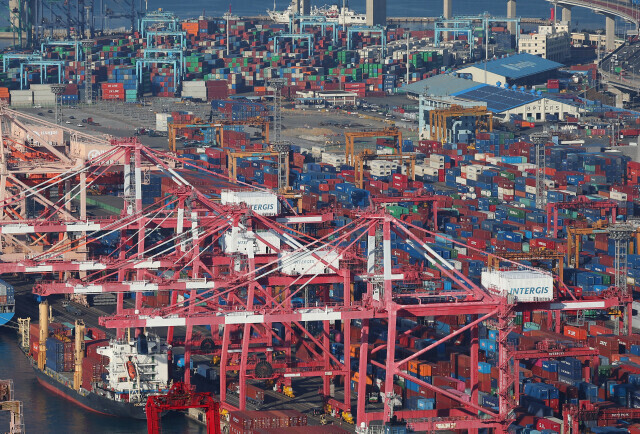hankyoreh
Links to other country sites 다른 나라 사이트 링크
Korea’s manufacturing sector sees worst decline since 1998 Asian financial crisis

South Korea’s manufacturing sector in 2023 saw its greatest reduction in scale in 25 years, since the Asian financial crisis of 1997. Absent a major economic crisis, this drastic fall in manufacturing is being attributed to the domestic industry’s overreliance on the semiconductor sector. Amid withering consumption in the wider economy, South Korea’s economic recovery has been in a lull since October of last year.
According to data released by Statistics Korea on Wednesday, South Korea’s industrial production index in 2023 was 105.6 (100 in 2020), exhibiting a 3.9% drop compared to the previous year. This represents the biggest reduction since 1998 (-6.5%). Moreover, the absolute scale of industrial production fell below 2021 levels (108.4). This is the sixth time that South Korea’s industrial production has fallen compared to the previous year since 1975, when the government began collecting relevant data.
The semiconductor industry is responsible for this drop in production. The chip industry is currently lagging, seeing a 5.3% reduction last year as demand in the IT sector dropped. The lag in semiconductors has led to a drop in exports. Korea saw 12 consecutive months of reduced exports compared to the previous year until October of last year. Semiconductors comprise around 20% of domestic manufacturing, so if semiconductors take a hit, the entire industrial sector shakes from the impact.
Conversely, semiconductors also drove an economic recovery in the second half of last year. Yet because domestic consumption still lagged, the recovery was minimal. Signs of recovery have gotten even weaker since October 2023. South Korea’s current composite index of business indicators was 98.6 in December of last year, a reduction of 0.3 compared to the previous month. Indexes that predict the economic future within the next six months indicate four consecutive months of recovery, but the level of recovery has weakened since October of last year (0.3). The increase in December of last year was a mere 0.1.
Kong Mi-suk, an analyst for Statistics Korea, said that the country’s economy is “still in a good state” according to the composite indexes. “The data indicates that the current economic recovery is much weaker than originally anticipated,” she added.
The government and economists are especially concerned about the lack of consumption. Domestic consumption in 2023 (retail) dropped by 1.4% compared to the previous year. That’s the biggest drop since 2003, when it fell 3.2%. While consumption of durable goods like passenger cars saw a 0.2% uptick, consumption of nondurable goods like food products was down 1.8% and semidurable goods like clothing down 2.6%. The figures show that consumers are tightening their belts at a time of high interest rates and inflation.
Economic forecasters see lean consumption ahead for the year as well.
“We’re predicting that we’ll see a recovery in exports but sluggish domestic consumption and backtracking,” said Chon So-ra, who oversees economic forecasting at the Korea Development Institute. “It’s possible that stagnant demand will continue through this year due to high interest rates and other factors.”
Kim Kwi-beom, who oversees economic analysis at the Ministry of Economy and Finance, echoed that “because interest rates are on the high end, stagnancy in demand is going to last longer.” However, Kim pointed to bonuses and rising wages as “positive factors” in this environment.
By Ahn Tae-ho, staff reporter
Please direct questions or comments to [english@hani.co.kr]

Editorial・opinion
![[Column] Season 2 of special prosecutor probe may be coming to Korea soon [Column] Season 2 of special prosecutor probe may be coming to Korea soon](https://flexible.img.hani.co.kr/flexible/normal/500/300/imgdb/original/2024/0426/3317141030699447.jpg) [Column] Season 2 of special prosecutor probe may be coming to Korea soon
[Column] Season 2 of special prosecutor probe may be coming to Korea soon![[Column] Park Geun-hye déjà vu in Yoon Suk-yeol [Column] Park Geun-hye déjà vu in Yoon Suk-yeol](https://flexible.img.hani.co.kr/flexible/normal/500/300/imgdb/original/2024/0424/651713945113788.jpg) [Column] Park Geun-hye déjà vu in Yoon Suk-yeol
[Column] Park Geun-hye déjà vu in Yoon Suk-yeol- [Editorial] New weight of N. Korea’s nuclear threats makes dialogue all the more urgent
- [Guest essay] The real reason Korea’s new right wants to dub Rhee a founding father
- [Column] ‘Choson’: Is it time we start referring to N. Korea in its own terms?
- [Editorial] Japan’s rewriting of history with Korea has gone too far
- [Column] The president’s questionable capacity for dialogue
- [Column] Are chaebol firms just pizza pies for families to divvy up as they please?
- [Column] Has Korea, too, crossed the Rubicon on China?
- [Correspondent’s column] In Japan’s alliance with US, echoes of its past alliances with UK
Most viewed articles
- 1‘We must say no’: Seoul defense chief on Korean, USFK involvement in hypothetical Taiwan crisis
- 2Is Japan about to snatch control of Line messenger from Korea’s Naver?
- 3[Editorial] Korea’s surprise Q1 growth requires objective assessment, not blind fanfare
- 4Division commander ordered troops to enter raging flood waters before Marine died, survivor says
- 5[Reportage] On US campuses, student risk arrest as they call for divestment from Israel
- 6Korea’s 1.3% growth in Q1 signals ‘textbook’ return to growth, says government
- 7No good, very bad game for Korea puts it out of Olympics for first time since 1988
- 8Flying “new right” flag, Korea’s Yoon Suk-yeol charges toward ideological rule
- 9N. Korean delegation’s trip to Iran shows how Pyongyang is leveraging ties with Moscow
- 10[Special report- Part III] Curses, verbal abuse, and impossible quotas